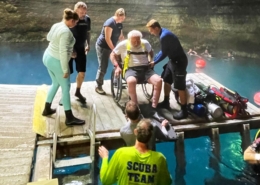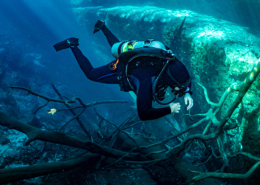Is Buoyancy Control a Specialty?
By Mark Powell
A topic that generates considerable online discussion is whether buoyancy control should be a specialty.
- One camp says no. They believe that, if entry-level instructors do their job, there should be no need for a buoyancy control specialty.
- The other camp argues there is not enough time to teach buoyancy control in an Open Water Scuba Diver course. They believe a follow-up to improve divers’ buoyancy skills is a useful additional course.
The short answer is, do both
The arguments can get very entrenched. They often widen to include other topics. I will tackle this subject head-on, showing there are strong points in each argument. I will also describe the practical approach adopted by SDI when teaching buoyancy control. The main question is whether to teach buoyancy solely in the Open Water Scuba Diver course or teach it as a specialty. The short answer is, do both.
Buoyancy control is an important part of entry-level training. However, there is plenty of room for improving divers’ buoyancy skills with follow up courses.
As an analogy, look at decompression theory. The SDI Open Water Scuba Diver course includes a section on this topic. Few, however, would argue this course should include all aspects of decompression theory. It is normal, even desirable, to save more detailed information for advanced courses.
Buoyancy is a fundamental part of diving
At a recent Instructor Trainer Workshop (ITW), a candidate stated, “Buoyancy control is not a part of diving. It is diving.”
The feeling of weightlessness is one of the best parts of diving. The ability to descend and ascend effortlessly are essential parts of learning to dive. So is the ability to maintain position in the water column. Divers who cannot control buoyancy should not pass the Open Water Scuba Diver course.
However, many instructors consider buoyancy control “just another skill.” Just one more on a list of several skills instructors must tick off before certifying entry-level students. They feel teaching fin pivots or, even worse, Buddha hovers somehow constitutes teaching buoyancy control.
Once the instructor checks off this “skill,” students are often denied further instruction in or practice of buoyancy. This does not constitute mastery of buoyancy control. Thus, the need to teach remedial buoyancy control courses is often to overcome substandard entry-level training.
SDI standards are clear
To be certified as SDI Open Water Scuba Divers, students must be able to:
- Hover
- Perform a controlled descent
- Perform a controlled ascent
In other words, show neutral, negative and positive buoyancy. To do this, the Instructor Manual explains that students must understand a range of concepts. These include:
- The relationship between proper weighting and buoyancy control
- Use of a buoyancy control device or dry suit
- Using breath control for fine-tuning
They must also understand:
- Differences in buoyancy between fresh and salt water
- How buoyancy changes are greater in shallow water than at depth
The goal for hovering is that “the diver will be able to hover motionless (without kicking or sculling) in the water for at least 30 seconds using buoyancy control.” For ascents and descents, students must be able to do this mid-water without visual references.
If instructors do a good job of covering all the required elements, students should have a fundamental mastery of buoyancy control. They should be able to maintain their position in the water throughout the dive.
This does not mean there is nothing more students can learn. Even the best instructors cannot teach every aspect of buoyancy control in entry-level classes. There is always room to improve.
The Advanced Buoyancy Control Course
The SDI Advanced Buoyancy Control course can help divers receive additional coaching on how to fine-tune buoyancy. It should also cover how to ensure they maintain their buoyancy while:
- Performing other tasks
- Dealing with emergencies
It should further teach students how to anticipate buoyancy changes. This will allow divers to deal with these changes in advance rather than reacting to them once they have happened. It is also an invaluable opportunity for students to spend time with an instructor fine tuning their buoyancy skills and developing a higher level of control. A good instructor can point out mistakes or improvements that it might take months of effort and frustration for the student to work out on their own.
It’s unfortunate some instructors consider buoyancy to be just another skill on a checklist rather than a fundamental part of diving. This devalues the concept of a follow-on Buoyancy Control class. How? By turning it into a remedial Open Water Scuba Diver buoyancy lesson. It has the potential to be so much more.
SDI Instructors should always ensure their entry-level students are capable of basic buoyancy control. They should not be afraid, however, to allow students to further improve and fine-tune their buoyancy. The SDI Advanced Buoyancy Control course provides that opportunity x










Zanechajte komentár
Chcete sa pripojiť k diskusii?Neváhajte prispieť!